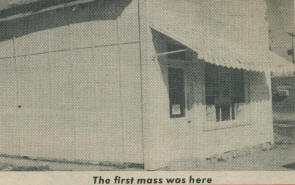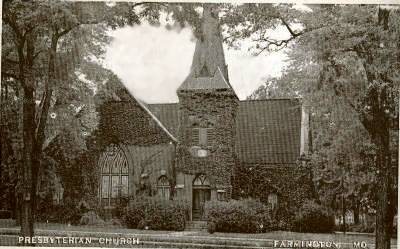CHURCH
INDEX PAGE
HOME PAGE
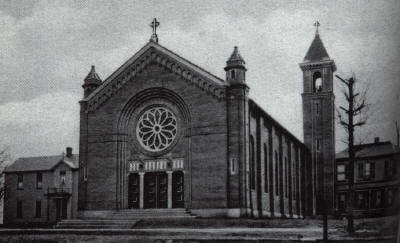
St. Joseph Catholic Church
|
RELIGIOUS
BOND CONTINUES TO TIE FARMINGTON
WITH MRS. SARAH MURPHY
The Daily Journal, Flat River, Mo., Monday, March 19, 1979 |
The
religious atmosphere of Farmington that is still prevalent today may have been acquired in
the early 1800s when Mrs. Sarah Barton Murphy, the widow of William Murphy, arrived with
her family to make their home. Murphy had made
a claim on the site that later became Farmington, but he died before the return trip from Tennessee
was made.
Today, there are
nearly 20 denominations represented in the city of Farmington. There are four churches within four blocks on Columbia
Street: the Presbyterian, First Free Will
Baptist, Christian, and Church of Christ.
The first mass celebrated in Farmington was at the home of Mr. And Mrs. Thomas Lang
in 1862. The house still stands at 233 E. Columbia
and it is occupied by Koen Real Estate Co.
Through the efforts of Mrs. Murphy, a log cabin was constructed in which she
taught the first Sunday school west of the Mississippi in 1805. She also donated an acre of ground for church
purposes, which is now part of the Masonic Cemetery.
A church directory dated Jan. 20, 1905 shows the following churches
were in Farmington: Presbyterian, Methodist
Episcopal South, Methodist Episcopal, Baptist, Christian, Lutheran, and Catholic. There are now these churches in existence: Assembly of God, Calvary Temple, Christian
Science, Church of Christ, First Church of God, Church of Jesus Christ of Later Day
Saints, Farmington Christian Church, First Baptist Church, First Church of the Nazarene,
First Free Will Baptist Church, First United Baptist Church, Grace Baptist Church,
Memorial Methodist Church, Presbyterian Church, St. Joseph Catholic Church, St. Paul
Lutheran Church, and United Pentecostal Church.
Five parochial schools located in the city |
Five parochial
schools are located in Farmington. St. Joseph’s
Catholic Church and St. Paul’s Lutheran School have, for years, operated their own
elementary schools. They have been more
recently joined by church schools operated by the Seventh Day Adventist Church, the Free Will
Baptist Church, and the Pentecostal Church.
The present site
of St. Joseph’s Catholic Church was accepted in 1869.
A frame church was originally constructed at the same site as the present one. In 1890 donations were accepted for the building of
a parish rectory, which was immediately constructed under the direction of the Rev. Fr.
Shaw, the first resident pastor.
Fr. Shaw was
succeeded by the Rev. Fr. John M. Kern in 1892. The
Rev. Fr. James Toomey was appointed pastor on Aug 14, 1897 and to his untiring energy and
zest the parish owes much of what it is today. With
a very small and scattered congregation he laid a very firm foundation for the future
growth. In 1897 he opened a school in the
sacristy of the church, which he taught himself. Around
1900, ground was obtained and the front section of the convent was erected. The first nuns to teach at St. Joseph’s were
Dominicans from New York who came in 1903. They
left after two years and Fr. Toomey resumed teaching the pupils, now numbering 100. Fr. Toomey died in April 1906. The Rev. Fr. Bernard Stolte succeeded
Fr. Toomey and secured the services of two lay teachers from St. Louis to continue the
school. After 15 months, Fr. Stolte was
transferred and was succeeded by the Rev. Fr. Joseph Collins in October 1907. Fr. Collins procured the Ursuline Sisters to
teach. Parish enthusiasm grew and plans were
made for a new church. In 1911 a contract was
signed for the building of the present Romanesque church.
Ground breaking took place March 17, 1912. A
total cost for the completed structure was $20,000.
In 1914, Fr.
Collins was succeeded by the Rev. Fr. John R. Morgan.
At this time there were so few children in school that it was closed the
following year. Miss Willa Ryan (now Mrs.
William Meyer), Miss Effie Lawrence, and Miss Genevieve Huss instructed the children for
First Holy Communion. In 1918 Fr. Morgan
joined the U.S. Army and the next pastor was the Rev. Fr. John Ryan who reopened the
school, secured the services of the Loretta Sisters, and paid off the debt on the church
property. The Rev. Fr. John S. Kelley came to Farmington
in 1922 succeeded by the Rev. Fr. Skaer in 1924. A
committee composed of Fr. Skaer, B.T. Gentges, Tom Burks, and Edward Effrein secured the
present pipe organ.
The Rev.
Fr. Edward O’Toole was assigned to Farmington in 1934 and during his time the present
New Calvary Cemetery was purchased. Fr.
O’Toole started drawing plans for a new school and rectory. The Rev. Fr. William Glynn was assigned as pastor
in 1939 by stayed only six months. The Rev. Fr. Robert McKeon was appointed in 1939 and
through his efforts Carleton College at 606 Overton was purchased. The Catholic school, which until then had been
conducted in the convent building, was later expanded to include the high school grades. The first high school graduation was held June 1,
1952 with the School Sisters of Notre Dame in charge.
Fr. McKeon was replaced in 1949 by the Rev. Fr. Joseph Gottwald and through
his efforts the present grade school building was erected and dedicated on Oct. 2, 1960.
Fr.
Gottwald was replaced by the Rev. Fr. William Burke who assumed the responsibility of
retiring the debt incurred by the new school building.
The Rev. Fr. Jerome Buchheit was appointed pastor April 1, 1967. During his tenure the church was carpeted and
air-conditioned, and the present rectory was built. Spiraling
costs of education and dwindling student enrollment, especially from neighboring parishes,
brought the operation of St. Joseph High School into an impossible financial situation;
and in the spring of 1968 the decision was made to close it in June of that year.
The
Rev. Fr. Thomas F. Albrecht, along with the Rev. Fr. Robert H. Babka as associate pastor,
was, on June 5, 1974, given the responsibility for the spiritual care of St. Joseph’s
parish family. During Fr. Albrecht’s
administration, the Carleton College building was sold and the classes were moved from
that building to the school building on Ste. Genevieve Avenue. The seventh and eighth grade classes were moved to
the convent building on the north side of the church.
The Sisters who were living in the convent moved to a house at 119 South
Carleton, which was rented for them from Clarence Layton.
During Fr. Donald Rau’s administration, the convent building became
unusable for holding classes and the seventh grade was moved to the grade school cafeteria
and the eighth grade held classes in the basement of the rectory. Because of the critical situation, Fr. Rau sought
and obtained permission to add two rooms onto the present grade school building. Before construction began, Fr. Rau was transferred
to St. Louis. He was succeeded by the Rev.
Fr. Jerome O. Reisch on June 14, 1978.
Though Fr. Reisch’s efforts, groundbreaking for the new addition took
place on Nov. 12, 1978. Funeral masses were
celebrated here and in St. Louis and he was buried in St. Peter and Paul’s Cemetery
in St. Louis on Nov. 25, 1978. Fr. Babka again
resumed temporary administration of the parish until the arrival of the Rev. Fr. Robert L.
Corbett, who took up pastoral duties on Feb. 14, 1979.
Presbyterian missionary came in 1882 |
To
a tiny courthouse village came a Presbyterian missionary, Joseph M. Sadd and his wife. They rented a two-room cabin where Sherman’s
Store is now. In it Mrs. Sadd taught Sunday
School, a Subscription School the other six days, and prayer meetings were held each
Wednesday evening. When Mr. Sadd was not
traveling through what are now Ste. Genevieve, Madison and other counties seeking out
Presbyterians and converts, Worship was held in the log courthouse.
The Presbyterian
Church of Farmington was organized on May 18, 1832 with seven members and Alexander Boyd
was elected the first Elder, May 21, 1832. Four
more members were added May 21, 1832.
During 1836, Luther S. Van Dorn, pastor, the first church building was
constructed, at the corner of Columbia and “A” Streets. After many rebuildings it is the Church of Christ
today. Thomas Donnell of Bellevue Presbyterian
Church, Caledonia, preached the sermon of dedication.
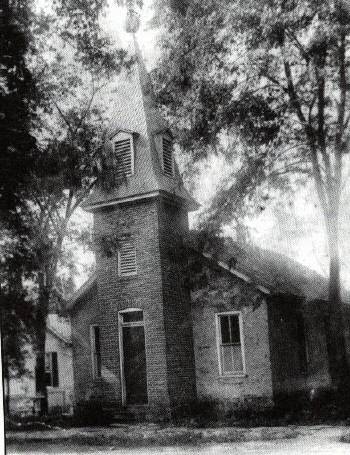
The first Presbyterian Church in Farmington.
|
Under the
pastorate of James A. Creighton the present sanctuary was constructed during 1884.
Since 1832
Presbyterians have sought to set an example of Worship and work in Farmington. Worship has been led by 24 pastors. Work can be seen
in service to persons in need through Elmwood Seminary, and early
girl’s school.
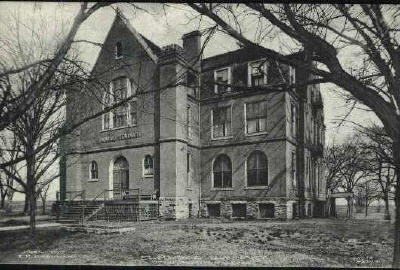
Elmwood Seminary
|
The Presbyterian Children’s
Home, on the Elmwood grounds, and Presbyterian Homelife, each of which was begun under the
leadership of the congregation.
Lutheran Church founded in 1873 |
St. Paul’s
Lutheran Church, Farmington, was organized in 1873. Around
1858 a Lutheran man by the name of August Gockel, moved to Pilot Knob. He asked his former pastor, the Rev. J.F. Buenger,
of the Immanuel Lutheran Church of St. Louis, to come and preach occasionally. Rev. Buenger agreed to do so and, before long,
organized a congregation with the Lutherans living in Pilot Knob and vicinity.
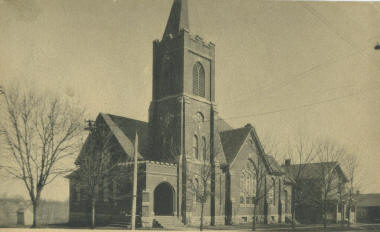
St. Paul's Lutheran Church
|
The
congregation grew so rapidly that it became necessary to call a resident pastor. Candidate Carl Graeber, a graduate of Concordia
Theological Seminary of St. Louis, received and accepted the call. He was installed in 1864 as the first Lutheran
pastor in this section of the state and served until 1866.
Rev. Graeber did
not confine his activities to Pilot Knob but preached also at Iron Mountain and near Farmington. In the beginning, services for the Farmington
people were held in a public school building two miles south of Farmington at a place
called Copenhagen.
From
1871 to 1875 Pastor F.C. Besel of Gordonville came to Farmington regularly, once a month,
summer and winter, riding 12 miles in a wagon and sixty miles on a slow accommodation
train to hold services.
The first
church was built in 1875 at a cost of $2,000. St.
Paul’s congregation was received into membership of the Evangelical Lutheran Synod of
Missouri, and Other States in 1879. Two years
later the Ladies Aid of the Farmington church decided to pay 10 cents per month dues and
they quilted to pay for the first organ in the church.
There were 300 members at that time. The
present building, dedicated in 1908, was erected at a cost of $16,000.
A few weeks after the arrival of the first resident pastor, the Rev. C.F.
Obermeyer, in 1874, a school was opened and 19 children were enr4olled the first day. The number soon increased to 40. From its earliest beginnings, St. Paul’s Lutheran
Church has supported and maintained its parochial school.
The congregation erected its first school building in 1896. The building that is now in use was built in 1926. The first kindergarten in the history of the Farmington
schools and of St. Paul’s congregation was started in 1943 with morning classes only. Enrollment has varied through the years, the peak
being reached in 1957 when 141 children were enrolled.
The Rev.
Merlin Wegener, who serves the church as pastor, came to St. Paul’s as its twelfth
pastor and was installed on May 6, 1973.
A large tent
revival led by the Rev. Damon Dodd (now the author of a book of the history of the Free
Will Baptist denomination) attracted much attention, and many of the visitors to these
services continued to worship with the growing mission.
It
became apparent that larger facilities were needed, and the possibility of chartering the
mission into a church was considered. About
this time providence intervened; the city’s two Methodist churches located on West
Columbia Street had combined congregations and were ready to move into their new building
on North Street.
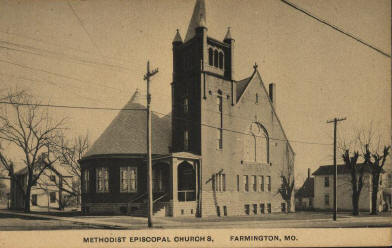
Methodist Episcopal Church South
|
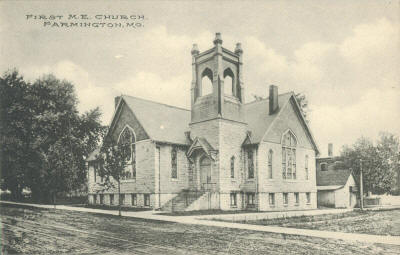
Methodist Episcopal Church North
|
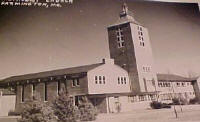
New M.E. Church on North Street
|
The mission’s leaders were
contacted by the pastor of the Methodist Church, the Rev. Elbert Cole, about the
possibility of buying the old facility on the north side of Columbia. Details were worked out, the sanctuary building was
purchased, and the church was chartered, under the leadership of the Rev. James Barker,
now pastor of the Leadington Free Will Baptist Church.
Christian Academy founded in 1977 |
From this
tiny group of dedicated Christians, today’s church pastured by the Rev. James
McAllister has grown into two three-story education buildings, an average Sunday School
attendance of 420, a full-time staff of six, a Christian school, kindergarten through 11th
grade with 100 students, and a bus ministry with four buses and one van.
A new
ministry to the aged and shut-ins, the Golden Agers, was implemented in February under the
direction of Richard Keys.
A
“Church on the Grow for Christ” is the motto on the modest sign in front of the
78-year-old sanctuary, and crowds of visitors each Sunday attest to this.
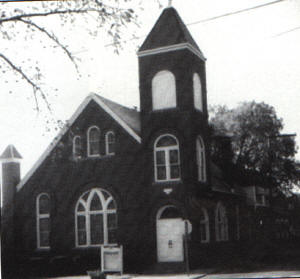
Church of Christ
|
The Church
of Christ, Columbia and A Streets, is located on the original site of the Presbyterian
Church, which was built in 1836, the year Farmington was incorporated into a village. That building later housed the Farmington Christian
Church. The building was later rebuilt in 1868
and building funds were provided through the generosity of M.P. Cayce. The pastor was the Rev. George Harian. The building is now the home of the Church of Christ
with a membership of approximately 40 people.
Now
celebrating its 25th anniversary, the First Free Will Baptist Church of
Farmington had its start as a tiny mission church in a rented store building in a
secondary business area.
Probably
never dreaming that the desire of a few small families who wanted to worship together in
their own denominational church would someday have one of the best-attended Sunday Schools
in the area, these faithful few began attending worship services in half of a brick duplex
building on Harrison Street. Sunday School
classes were so small that they were held in cars parked on the street in front of the
building.
Farmington
Christian Academy was established in 1977 as a ministry of the First Free Will Baptist
Church of Farmington.
The school opened its first year with an enrollment of 63 for grades K-9. The following year grades 10 and 11 were added, and
enrollment jumped to 98.
Religious Education Continues to Expand in Farmington |
F.C.A.
emphasizes Christian training with a close relationship between the school, the home and
the local church. Self-discipline, Christian
character, and patriotism are considered essential elements in producing Christian workers
and responsible citizens.
A dedicated and
qualified staff provide a vital link between home and school.
[missing
text] . . . after years of disciples’ worship and activity in the area dating
from the 1820s. The congregation belongs to
the denomination known as the Christian Church (Disciples of Christ) which came into being
in the early nineteenth century.
The
congregations of the Church of God, Farmington, go by the name because they find that term
often applied to the early church in the New Testament.
They say they like to get as close as they can to those early days and the
teachings of Christ.
But “Church
of God” has other meaning for them. To
that congregation the term can apply to all Christians who have given their lives to
Christ. By using that name they feel they
identify with all born-again Christians, no matter what barriers some of them may raise
among themselves.
They have
Christian interests far outside local boundaries, and join with sister congregations
across the country in carrying on foreign mission work in 14 countries, in sponsoring
church colleges, in publishing Christian literature, in caring for aging ministers, in
promoting Christian education, in extending work into new communities and among
underprivileged people here in North America.
It is apparent
that the spiritual needs of Farmington residents are being met. A history or summary was not available for each of
the city’s many places of worship.
CHURCH
INDEX PAGE
HOME PAGE
{Thanks to Jeanne "Hunt" Nassaney for transcribing
this article!}
This page was updated: Friday, 23-Feb-2024 12:39:28 MST
This site may be freely linked, but not duplicated in any way without consent.
All rights reserved! Commercial use of material within this site is prohibited!
© 2000 - 2025 MOGenWeb
The information on this site is provided free for the purpose of researching your genealogy. This material may be freely used by non-commercial entities, for your own research. The information contained in this site may not be copied to any other site without written "snail-mail" permission. If you wish to have a copy of a donor's material, you must have their permission. All information found on these pages is under copyright of Oklahoma Cemeteries. This is to protect any and all information donated. The original submitter or source of the information will retain their copyright. Unless otherwise stated, any donated material is given to
MOGenWeb to make it available online.
